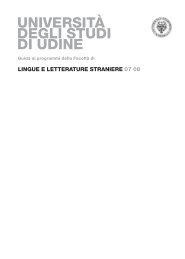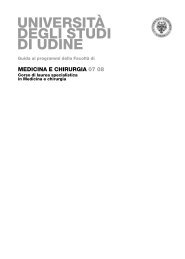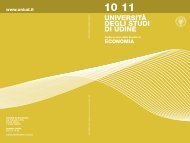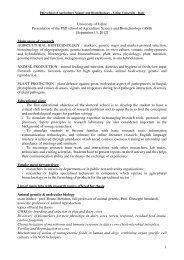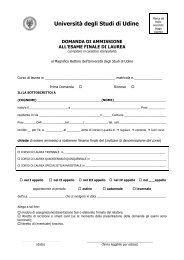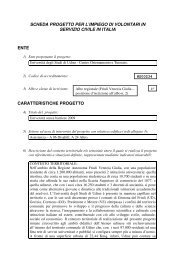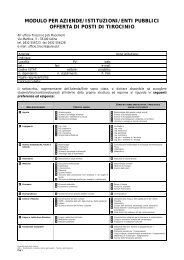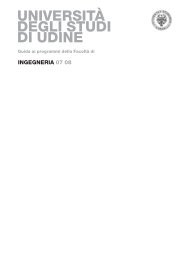â¢GUIDA ECONOMIA 07-08 - Università degli studi di Udine
â¢GUIDA ECONOMIA 07-08 - Università degli studi di Udine
â¢GUIDA ECONOMIA 07-08 - Università degli studi di Udine
Create successful ePaper yourself
Turn your PDF publications into a flip-book with our unique Google optimized e-Paper software.
prospectus u<strong>di</strong>ne<br />
181<br />
Flow-based analysis.<br />
Economic and financial forecast.<br />
Pre-requisites<br />
The course of ‘Corporate economics’ is<br />
preparatory.<br />
Bibliography<br />
Course textbook<br />
- R. CAPPELLETTO, Elementi <strong>di</strong> finanzia<br />
aziendale, Giappichelli, Turin, 2003.<br />
CORPORATE FINANCE<br />
ADVANCED COURSE<br />
Prof. Roberto Cappelletto<br />
Aims<br />
The course aims to analyse from a critical<br />
perspective the main theoretical models<br />
developed by modern corporate finance<br />
theory in order to provide a wide framework<br />
for the comprehension of fun<strong>di</strong>ng<br />
decisions.<br />
Contents<br />
Determinants of financial dynamics.<br />
Measuring cash flows (Capital Budgeting).<br />
Perspective cash flow variability and corporate<br />
risk.<br />
Financial value of time: the yield curve.<br />
Financial value of time: the cost of capital.<br />
Valuing investment choices.<br />
Valuing financing choices.<br />
Determination of the optimal financial<br />
structure.<br />
Determinants of interest rates and risk<br />
valuation.<br />
Portfolio <strong>di</strong>versification and risk pricing.<br />
Capital Asset Pricing Model and its evolution.<br />
Arbitrage Price Theory.<br />
Capital market efficiency.<br />
Determination of the cost of capital.<br />
Financial decisions and the financial<br />
environment.<br />
Financial strategy decisions.<br />
Pre-requisites<br />
The course of ‘Corporate finance’ is<br />
preparatory.<br />
Bibliography<br />
- S.A. ROSS, R.W. WESTERFIELD, J.F. JAFFE,<br />
Finanza aziendale, Il Mulino, Bologna,<br />
1997, chapters 1-19.<br />
DATA ANALYSIS<br />
(CdL BE, EBA)<br />
Prof.ssa Laura Pagani<br />
Contents<br />
1. Introduction<br />
Introduction to basic statistical concepts:<br />
observed phenomenon (<strong>di</strong>stinguishing<br />
between <strong>di</strong>fferent kinds of variables); statistical<br />
units; population; complete or<br />
sample survey.<br />
2. Frequency <strong>di</strong>stribution<br />
Absolute, relative and percent frequency<br />
(both simple and cumulative) for <strong>di</strong>screte<br />
variables (both in the qualitative and<br />
quantitative case). Absolute and relative<br />
frequency and density functions for the<br />
continuous variable case. Frequency <strong>di</strong>stributions<br />
graphs. Distribution function<br />
for the continuous variable in the case of<br />
class categorization.<br />
3. Indexes<br />
Location measures: mean, me<strong>di</strong>an,<br />
mode, percentiles. Dispersion measures:<br />
range, interquartile range, variance, standard<br />
deviation and coefficient of variation.<br />
Gini concentration index (with the Lorenz<br />
curve plot). The box & whiskers plot.<br />
4. Bivariate analysis<br />
Association analysis: two-way frequency<br />
tables, scatter plot, con<strong>di</strong>tional mean and<br />
variance, covariance and Pearson correlation<br />
index. Simple linear regression: least<br />
squares point estimates; regression line;<br />
goodness of fit.<br />
5. Exercises<br />
All topics will be supported by some<br />
examples and exercises.



